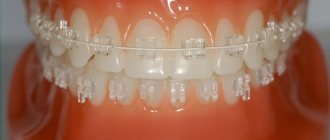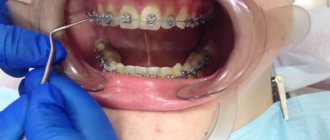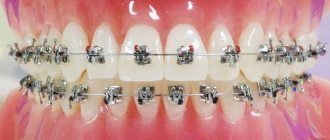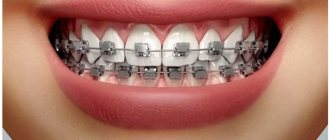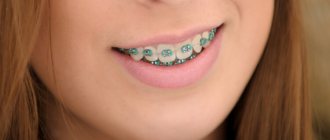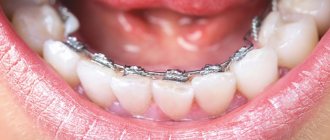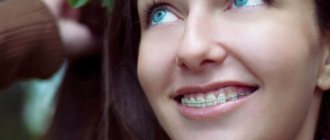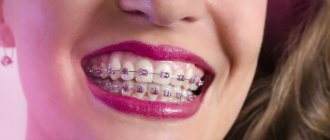Home » Braces systems » Consequences of wearing braces and problems after removing them
The use of braces makes it possible to correct a non-standard bite and return teeth to the correct position. However, despite the excellent final result of using braces, wearing them can be significantly delayed, and the treatment period will be calculated in years, not months.
What can happen to teeth in a few years? Yes, anything! The patient should prepare for any consequences, but worrying in advance that something might go wrong is pointless, since all possible complications can be eliminated with today’s level of medical development. Now let’s look at the main problems that may arise for a person who has chosen treatment with braces.
Depression and moral discomfort
The safety and painlessness of installing braces has been proven and does not require additional confirmation. Despite this, many patients continue to experience stress before undergoing their placement procedure.
The reasons for this state of affairs may be different, however, the most common circumstances that can cause moral discomfort are the following:
- Foreign body in the mouth . When, while chewing food, a small particle of food gets stuck in a person’s teeth, this is already unpleasant, and when both jaws are affected by a foreign body, this can lead to the most unpleasant psychological consequences.
- Pain in teeth . This pain is aching and it spreads to all the teeth, causing the patient a lot of inconvenience. And although the painful sensations from wearing braces disappear after ten days, an unpleasant aftertaste remains.
- The need to answer questions from others about wearing braces every time . To get rid of unpleasant consequences of this nature, it is better to prepare answers to most of the questions in advance.
- Concerns about possible loss of braces and damage to them . Although braces are quite durable, a person constantly thinks that he can damage them, and they, in turn, will damage the enamel of the teeth. Most of these fears are unfounded, and if problems may arise, they will be associated with the consumption of too solid foods.
Minuses
The disadvantages of braces include the need for regular teeth cleaning and proper and high-quality oral care. The presence of foreign elements on the teeth serves as a contact point for the retention of food and microorganisms. To prevent the occurrence of caries and gingivitis, it is necessary to thoroughly brush your teeth, use dental floss, brushes, and rinse your mouth after each meal.
It must be remembered that after installing the device, you must adhere to some dietary restrictions. Avoid eating extremely hot or cold foods. A sudden change in temperature can cause the bracket to come off the tooth. It is also recommended to exclude from the diet foods that can harm the braces system: crackers, dried fruits, nuts, toffees, caramels.
Also, the disadvantages of using braces include the duration of treatment (on average from 1 to 3 years), the appearance of the structure and psychological discomfort (especially if these are not lingual or aesthetic braces), as well as the high cost of treatment, which is not for every person is acceptable.
Many people are interested in the question: can braces be harmful to teeth? The only harm that can be caused is a violation of the surface layer of enamel. The problem is extremely rare and can be easily corrected with a photopolymer filling. Such a nuisance can arise when installing braces, when the technology for gluing them is broken, or due to poor hygiene, when food gets clogged under the arch and a carious process occurs.
With proper installation of the structure and careful dental care, no problems arise, so talk about the dangers of braces is often nothing more than an invention of people who are simply afraid to wear an orthodontic device.
Problem #1. Rubbing the mucous membrane with braces
Discomfort associated with rubbing the oral mucosa especially worries the patient in the first stages of wearing braces. Also, this problem can appear in the middle and at the end of treatment - alas, it is not uncommon.
The gums rub as part of a natural process as the mucous membrane gets used to the braces, and this adaptation process generally lasts only one week. In this case, some, slightly noticeable change in the shape of the patient’s face cannot be ruled out.
Important! The patient needs to remember: even the slightest irritation of the mucous membrane is already a reason to consult a doctor, and inaction can lead to dire consequences, because wounds will become an excellent place for the formation of infections and the accumulation of bacteria.
To eliminate unpleasant sensations, in most cases, the mucous membrane is treated with various rinses containing extracts of herbs and oak bark, and small wounds in the oral cavity are successfully healed.
The mucous membrane may also be damaged if the integrity of the braces system is compromised, for example due to:
- Peeling off the lock from the surface of the tooth . This often occurs due to the fault of the patients themselves - when they eat solid food. Sometimes the orthodontist is also guilty of this, using a filling compound instead of glue.
- Incorrect arc installation . This mistake can only be made by orthodontists who are just starting their practice - they can leave the end of the spring resting on the patient’s cheek, but this problem can also be solved - just contact the clinic for a correction.
- Applications of budget designs from unknown suppliers . If the braces are made at home and have defective components, they will also need to be replaced and in the future, systems only from well-known manufacturers will be used.
Problems after removal
After removing braces, discomfort may also occur. The main reasons for such situations are too much pressure on the teeth and little experience of the orthodontist.
Main problems:
- The color of the enamel changes . The discoloration is due to residues of the protective adhesive on the tooth surface. After hygienic brushing, the color returns to normal.
- Teeth become crooked . As a result of using the system, the arrangement of teeth, bone tissue and blood vessels changes. After removing the structure, the teeth “try” to return to their original place, but it is no longer there. Therefore, they become somewhere, which leads to their curvature. This situation can only arise if the patient refuses to install retainers, which are responsible for the final correct fixation of the teeth after removal of the structure.
- Large gaps form between the teeth . The cause of the problem is the same as in the previous case. Retainers will help fix it.
Problem #2. Difficulties with diction
It takes many years for the human articular apparatus to get used to the specific structure of the oral cavity and its volume. Therefore, even a small correction of the anatomy of the oral cavity can cause problems when pronouncing words. Perhaps vestibular braces do not so clearly indicate this problem, but the use of lingual devices may well lead to it, especially during the first month of wearing them.
Lingual braces have many small protrusions, and because of this, there is a high chance that the tongue will start to touch them. Over time, contact of the tongue with the structural components of the lingual systems can lead to irritation of the oral mucosa in the contact area, and a person’s speech will become distorted and slurred.
The above problem is solved by medical wax, thanks to the use of which all protruding parts of the braces are successfully closed, and therefore the presence of internal braces in the mouth does not cause any discomfort to the person.
Features of different types of braces
To eliminate the subjective disadvantages of braces and optimal treatment, it is necessary to decide on the choice of braces. There are several types of braces, and they all have their pros and cons.
- Metal braces. They are the simplest and most accessible. The advantages are low cost, durability, you can use different compositions of the material for allergies. Disadvantages: poor aesthetic performance.
- Plastic braces. They are more aesthetic, light plastic is not noticeable on the teeth. They are also the most inexpensive of aesthetic braces and are available to a wide range of people. The downside is that the color changes when eating food with dyes, they fade over time, and the design is not strong enough.
- Ceramic braces. Made from special high-strength material. These designs are the most popular in the line of aesthetic braces. They are durable, reliable, comfortable, do not change color when eating, and do not oxidize. The disadvantages include the high cost and complexity of installation.
- Sapphire braces. Made from innovative artificial sapphire. They are the most aesthetic, quite durable, and have an excellent appearance. The downside is the extremely high cost, limited indications for use (cannot be used for serious bite pathologies).
- Lingual braces. They are installed on the lingual or palatal surface of the teeth, completely hidden from the eyes of others. The advantages of lingual braces are complete invisibility and high strength. The disadvantages are the difficulties of hygienic care, impaired diction immediately after installing the system, as well as the very high cost.
To decide on the choice of braces, you need to take into account many factors: the type of bite and the complexity of the dental pathology, financial capabilities, duration of treatment, as well as the individual characteristics and desires of the patient. When choosing treatment, you can always find a compromise between the pros and cons of different types of braces; a qualified orthodontist will help you with this . Undoubtedly, the benefits of orthodontic treatment outweigh all temporary difficulties and possible discomfort, since straight teeth and correct bite not only make a person beautiful, but are also the key to good health.
Problem #3. Defective bite after treatment
Malocclusion of teeth after using braces is not considered uncommon, despite the fact that the process of installing and wearing these structures has been developed over the years.
The following problems may occur:
- inability to remove a partially erupted tooth
- curvature of the dentition
- protruding teeth forward
- incorrect jaw closure
Such consequences can be caused by one or several reasons at once. The main factors leading to undesirable results:
- Correction was carried out only on one row of teeth.
- At the end of wearing braces, the patient voluntarily refused to wear retainers.
- Medical error. No matter how professional a doctor is, he is still a human being and he tends to make mistakes.
- The bracket falls out and the patient continues to be inactive. When a brace comes off, the first thing a person using corrective systems should do is immediately contact their doctor, as otherwise the treatment process will be less effective.
Patients are interested - questions arise
Consequences and reasons for removing fours and eights for braces
During installation, it is often necessary to remove the fourth and eighth dental units in a row. Main reasons:
- All teeth must be placed in one row without displacement. If you leave the molars alone and allow them all to remain in place, there is a high risk that the process of wearing the structure will be accompanied by the inability of a row of teeth to become straight, since there is not enough free space for crooked units to move onto it.
- For symmetry and a good facial oval (removing figure eights).
By removing interfering dental units, the doctor puts the health and beauty of the patient’s smile first. At the time of the procedure, there may be no interfering elements, but the specialist understands that during the alignment process, over time, a serious lack of free space will arise for the teeth. In such a situation, it is useless to install leveling systems.
Without serious reasons, a qualified specialist will not remove a healthy unit. Depending on the situation, he can remove figure eights on two jaws, or he can limit himself to one element of the jaw.
Sometimes it is necessary to remove a figure eight that has not yet erupted to prevent the treatment from flowing in the wrong direction. This decision is made only after a jaw X-ray.
There is no gap left between the teeth, even in the place where they were pulled out, after the braces system. The teeth are aligned, forming a common, beautiful row.
Disadvantages and consequences of installing structures for teenagers
Installation of braces is advisable after the bite has already been completely formed (9 – 10 years). Some experts believe that at the age of 12–13 years the jaw is actively developing, and when interfering with this process, the possibility of unforeseen consequences cannot be ruled out.
The final decision is made individually for each patient based on the results of x-ray diagnostics.
Based on medical practice, braces affect not only the teeth, but also the skull as a whole, and therefore affect posture and even hormonal levels. Unfortunately, this influence is not always favorable.
Some teenagers respond well to treatment with orthodontic products, while others do not.
In order for the products to work for your benefit, creating a beautiful smile, and not disfiguring your posture during its formation, you need to approach their process correctly, and here a lot depends on the parents. Here's what some doctors advise:
- Before installing an orthodontic structure, it is important to consult not only an orthodontist, but also an osteopath, since he is the one who knows a lot about the relationships in the human body. Depending on the state of the teenage body, this specialist can predict and prevent possible negative consequences. Sometimes it is advised to postpone treatment with braces or correct the bite in another way.
- While wearing the device, it is advisable for the teenager to regularly visit an osteopath, who will relax tensions and help the body adapt to the installed products. In large dentistry this is the norm: correction by an orthodontist and, in the near future, a visit to an osteopath.
- After removing braces, time is needed for osteopathic work to adapt the body to new living conditions with a new bite (and without the usual pressure).
Lingual braces - negative aspects
The structure is mounted on the inner side of the tooth, making it almost invisible. Lingual systems have an aesthetic appearance and are relevant when it is necessary to correct complex anomalies.
Among the disadvantages, it should be noted the high cost of their installation, as well as the possibility of impaired pronunciation for some time. Such designs have a long installation and wearing time.
The use of lingual braces may cause the enamel to crack or create gaps after the braces are removed from the mouth.
Ceramic braces - disadvantages and complications
Ceramic models make teeth more attractive during treatment compared to other types of structures. They have virtually no effect on the quality of pronunciation.
The disadvantages include the high price and long wearing period. It is possible that one of the braces will come off. The use of adhesive systems will help to avoid this problem.
As for possible negative consequences, these include the development of caries or periodontitis in case of non-compliance with the rules of oral care.
Contraindications
All contraindications to the installation of braces can be divided into 2 types: relative (can be corrected) and absolute (cannot be corrected).
Relative:
- poor oral hygiene;
- development of caries or periodontitis in acute form;
- the presence of an allergic reaction to painkillers.
Absolute:
- the absence of one or more teeth in certain places;
- respiratory tract tuberculosis;
- dysfunction of the endocrine or immune systems;
- oncological diseases;
- diseases of the circulatory system;
- epilepsy;
- diseases of the central nervous system;
- drug addiction, alcoholism in chronic form.
Before installation, you must undergo a medical examination and then consult with an orthodontist.
What happens if you swallow a brace?
Braces are made from materials that are safe for the body. They will not irritate the esophagus, stomach and intestines. The lock of the system will pass through the gastrointestinal tract and leave the body naturally.
If a part with sharp edges is swallowed, it may cause pain. However, the walls of the esophagus are strong and elastic, so they can pass a small sharp object through without consequences. However, it is advisable to see a doctor to avoid complications.
In any case, to continue treatment of the bite, you must contact an orthodontist to install a new element.
What patients say about sapphire braces
Sapphire systems are more like jewelry and are often used by TV stars and public figures. The material for their production is aluminum monocrystals, which can adapt to any shade of enamel. They are translucent, so they practically blend with the shade of the teeth. The cost of installing such structures is the highest among all vestibular systems - from 70 thousand rubles. But the efficiency is an order of magnitude lower compared to metal braces.
Yuri, Moscow “In my youth, I considered straightening my teeth a useless exercise, and my parents didn’t really insist at the time. I thought that appearance would not be particularly important to me. But life played a cruel joke on me. I work as a toastmaster at weddings, and I simply need straight teeth. I decided to install sapphire braces, since they are the most invisible. I've been wearing them for a year now and don't want to part with them. They are practically not felt in the mouth and give my image some zest! I don’t feel any discomfort at all, and they don’t distort my diction either. The only problem with food at events is that I can’t eat everything that’s offered)))”
Inga, from correspondence on forums “I only got braces when I was 30. Before that, I had been saving for several years - I wanted sapphires as the most inconspicuous ones. I saw from a friend that they are really almost invisible - even in the photo!! You really can't see them there at all. If I didn't know, I definitely wouldn't have noticed. Even for selfies! So I don’t regret it one bit – they don’t interfere with my work or my personal life at all.”
Vestibular structures
When using braces, you should not use the term “harm”; the word “complications” is more appropriate here.
Each product element undergoes thorough examination and certification before entering the human oral cavity.
These orthodontic systems are placed on the outside of the teeth. The installation process is relatively simple and does not take much time. Such a system is visible when talking and smiling, but it can be decorated and made as harmonious as possible.
Unligated and classical systems
Bracket systems are also classified into two types depending on their design features. They are divided into:
- ligature (classical);
- non-ligating (self-ligating).
The first type of braces is distinguished by the presence of a special element in them, known as ligatures. The latter are made of plastic rubber, which is not dangerous to the body. Ligatures provide reliable fixation of the orthodontic arch in the grooves on the brackets. At the same time, she remains completely motionless.
Wearing ligature braces creates certain inconveniences. The patient needs to visit the orthodontist's office regularly (about once a month) for correction of the structure.
This need is explained by the fact that ligatures lose their initial elasticity over time, and therefore the effectiveness of the orthodontic arch decreases: its pressure weakens. In addition, during the treatment process, teeth have to constantly overcome friction.
On this topic
- Braces
Details about what is better: braces or plates
- Maria Konstantinovna Tevs
- October 5, 2020
Correcting a bite using ligature systems takes several years (on average 1.5-2 years). The treatment is not accompanied by pain due to the fact that the jaw muscles take part in the correction.
Discomfort occurs during the first few weeks, when addiction occurs. If the pain does not disappear within the specified period, then you need to contact the orthodontist again. The presence of this syndrome indicates the course of the pathological process in the oral cavity caused by the installation of a ligature system.
Such structures are fixed on the outside or inside of the teeth. They have a relatively low price.
Ligature-free braces do not have the disadvantages that characterize the latter. They do not contain rubber, due to which the orthodontic arch retains mobility. Self-ligating systems, compared to ligature systems, reduce the duration of bite correction by approximately 15%.
On this topic
- Braces
10 types of braces
- Maria Konstantinovna Tevs
- October 4, 2020
The peculiarity of such structures is that they are equipped with special clamps along which the orthodontic arch slides. The advantages of ligature-free braces include the following:
- reducing the duration of the arch replacement procedure;
- correction of teeth in a natural way, since they do not have to overcome the force of friction;
- reducing the frequency of orthodontic visits;
- easy maintenance compared to ligature systems;
- aesthetically attractive appearance;
- compact size, which reduces the period of adaptation.
Non-ligature structures are made from hypoallergenic materials, so they are safe for the body. The only drawback of these systems is their high cost.
Lingual and classical systems
Bracket systems are divided into two types depending on the location of the structure:
- classic;
- lingual.
On this topic
- Braces
Find out what to do if braces rub your cheeks
- Maria Konstantinovna Tevs
- October 5, 2020
The difference between these systems is that lingual ones are attached to the inside of the teeth. This arrangement sets them apart from other orthodontic appliances. Lingual systems correct the dentition while remaining invisible.
Among the disadvantages of these devices are:
- high price;
- installation complexity;
- high care requirements.
After installation of lingual braces, patients often experience impaired diction, which is restored within a few days while addiction takes place.
Temporary restrictions
It is permissible to install a brace system if you correct some factors that are a temporary ban on wearing the structure:
- caries;
- some gum diseases;
- presence of implants or crowns;
- allergic reaction to the installed material;
- defects and damage to enamel;
- diseases of the jaw and temporal joints;
- poor oral hygiene.
Temporary phenomena that do not allow the installation of orthodontic structures can be leveled out.
Reviews about ceramic braces
Unlike metal ones, ceramic braces are more aesthetically pleasing systems, as they have an almost identical shade to tooth enamel. Naturally, they cost an order of magnitude more. The designs of the most budget brands will cost at least 60 thousand rubles for installation on 2 jaws. Getting used to ceramic structures occurs quite quickly, since there are no sharp corners in the system. But the disadvantages include the duration of treatment.
Anastasia P., Nizhny Novgorod “Yesterday my daughter had her braces removed. We express our deep gratitude to the doctors for their advice to install ceramic systems. Throughout the entire treatment, they were almost unnoticeable and, contrary to all expectations, my daughter’s classmates never made fun of her!!! Now she can’t wait to go to class and amaze everyone with her great smile!”
P.I., Moscow “I had braces for 2 years. The longer I wore them, the closer they became to me. Now I have become confident, I smile almost all the time! I will try to persuade my wife to install ceramics too. I didn’t have any discomfort; caring for them was, of course, a bit difficult. But this does not depend on the type of structure - any braces need to be looked after most carefully. But over these 2 years, the ceramics became noticeably cloudy - this is clearly visible, because two locks had to be replaced - they came unglued. And the new ones have a whiter color. So this advice is useful to everyone: carefully monitor your hygiene!!!”
The benefits of braces
Wearing braces has a positive effect not only on a person’s appearance, but also on his health:
- Increased self-esteem. People with crooked teeth or misaligned bites often begin to smile shyly, close their lips, cover their mouths when laughing, or speak less when around strangers. They are trying to hide their crooked teeth. A beautiful smile after orthodontic treatment improves self-esteem and allows you to laugh, smile and speak for everyone to hear and see.
- Improving oral health. If your teeth are crooked and misaligned, it is quite difficult to clean them with a toothbrush. This can lead to tooth decay, darkening of the enamel and gum disease, further complicating the situation. After orthodontic treatment, patients can easily reach all surfaces of their teeth with brushing, resulting in a lifelong, dazzling smile.
- Improved overall health. The risk of gum disease increases due to the presence of misaligned or crooked teeth; bacteria from gum disease can penetrate into the general bloodstream and provoke the development of inflammation and secondary infections. A malocclusion can create difficulty biting and chewing food, which can negatively impact your overall health and nutrition. Straight teeth can help solve these problems. It's never too late to see the benefits of orthodontic treatment at age 7 or 70.
- Improved sleep and breathing. Most people do not know that the position of the lower jaw directly affects the ability to breathe freely. In addition, the width of the upper jaw and palate primarily affects the ability to breathe through the nose. Properly performed orthodontic treatment can have a positive effect on both areas of respiratory function. This technique allows children to slowly and comfortably increase the width of their palate and also helps the lower jaw grow forward, which greatly reduces the risk of developing obstructive sleep apnea or sleep disturbances as they get older. In adults, orthodontics can improve night breathing.
- Teeth protection. Teeth that are not properly aligned often experience uneven distribution of pressure and force when chewing or biting, which ultimately leads to wear and damage. In addition, malocclusion can increase the risk of damage to teeth and lips when playing sports such as football, basketball or baseball.
- Beautiful speech. Teeth are a key component in producing many of the sounds a person makes when speaking. Crooked teeth can make it difficult to pronounce certain sounds correctly, causing a lisp or whistling. Patients with malocclusion may also suffer from speech problems. Braces can realign teeth into an optimal position, allowing the lips, teeth and tongue to work together to reduce speech difficulties and increase confidence.
- Reducing pain. Poorly aligned teeth are also at a significantly higher risk of damage if a person is prone to bruxism at night. Long-term dental damage or malocclusion can lead to increased pressure on the temporomandibular joints, which in turn causes jaw pain, muscle and neck pain, and even headaches.
DETAILS: Colgate Ortho toothbrush for compact braces. soft heads, buy in Moscow pharmacies, Colgate Ortho for compact braces. heads are soft
Three types of absolute contraindications to wearing braces
- Systemic diseases that significantly complicate the patient’s general condition, which usually include a number of problems with the immune, cardiovascular, endocrine and hematopoietic systems, as well as oncology, tuberculosis and HIV.
- Diseases in which the process of healing and restoration of bone tissue is disrupted - from osteoporosis and dysplasia to congenital osteopathy and osteonecrosis.
- Neuropsychiatric diseases in which the patient is unable to cooperate with the orthodontist, since he does not perceive the manipulations being performed and cannot follow the recommendations given to him.
Fortunately, dentists rarely have to deal with absolute contraindications, but if a patient has such health problems, the possibility of prescribing orthodontic treatment is nullified.
Braces for children
It is recommended to install orthodontic systems for children if:
- large gaps between teeth;
- small interdental distances;
- uneven teeth;
- malocclusion;
- differences in jaw development.
Children's orthodontic systems differ from adults in their elasticity and relative cheapness. How braces are installed for children and adolescents depends on the type of structure. Children's braces are classified in the same way as adults.
